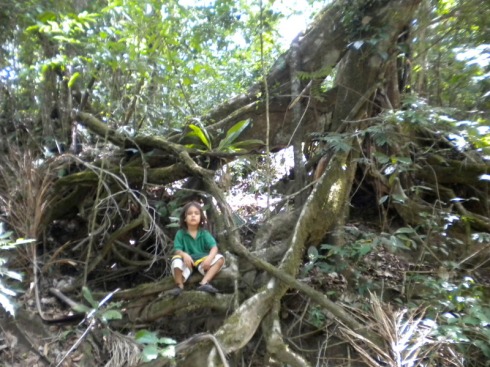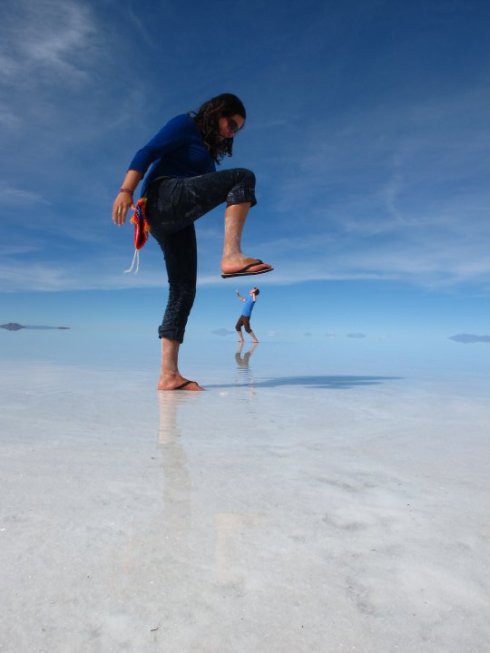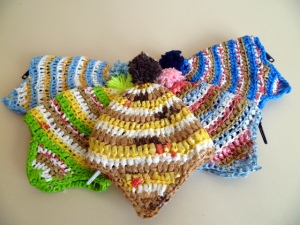This route is completely off the beaten path and this time, it’s the road less traveled for a reason.
The Lonely Planet claim that San José “merits a visit even if you miss all the others”? Bullocks! The reaction I got when I told locals that I went to San José was one of bewilderment. Apparently, San Xavier and then Concepción is the recommended route; not only is less travel time but the transportation is much easier, contrary to Lonely Planet reports. San José can be seen in less than 2 hours and though there is a scenic outlook atop a 3-hr hill climb, it’s much too hot and humid to do anything but splay in your hotel room with the fan on. They do make good textiles though, cotton-woven purses made from looms, but I hear that the artesanías in Concepción are much more interesting. The “neighorhood of artisans” marked on the tourist map is nothing more than private houses, but the women inside are incredibly friendly and willing to show you how they weave. All of the people I met in San José are incredibly nice, from the hotel owner to the tourist agency to the people working inside the church to the salteña vendor. When I arrived from Buena Vista with a warty hand of mosquito bites, the tourist agency gave me medicine. When I got burnt badly by a too-hot salteña, the church tour guide rushed off to find burn medicine. When I returned to tell the salteña vendor that his salteñas were too hot, he took me out to lunch and showed me around the town. Apparently, gasoline is smuggled to Brazil from here and hence, they also sell it in 2-liter coke-bottles!
Buena Vista is the launch point for more interesting Parque Amboro sites than you can see from Semaipata. However, because there are not many tourists here (I was the only one there at the time) and because the drive is much muddier and longer, the price for a tour is steeper, around $100/day and you will want a minimum of 2 days. Although I did not go on the tour, I had a thoroughly good time, visiting the Buena Vista coffee plantation (alledgedly the largest coffee exporter in Bolivia and they supply base beans for Starbucks), accidently eating some species in low population (in my defense, a referred friend recommended the dishes to me! And they told me that the jochi was a kind of pig, so I really thought that there were a lot of them out there and did not know that they breed only one youngin once a year), and going bird-watching/hiking in the 43-hectare forest plot of land adjacent to that of famed birdologist Robin Clarke. I caught ticks in the end, the effects of which I’m still feeling one month later, but I hear that all forests have ticks, even in Rurrenabaque. In an update, if you got bitten by ticks here, you will probably not have Lyme Disease. I got myself tested and it was negative. Phew!
Trip Details:
Buena Vista
- Transportation: From Cochabamba, you can take the bus to Santa Cruz and ask to be dropped off at Buena Vista. They will drop you off at a gasoline station and from there it is only a 5-block walk straight down to hit the main plaza.
- Lodging: La Casona is nice and cheap but there are no locks on the doors. I stayed at Residencial Nadia which was quite comfortable and included a private bathroom.
- Guides: I left my notebook of numbers and names at home, so forgive me for being vague. A good guide for Parque Amboro is the large office on the corner, right opposite to the Internet/telefone place on the corner and on the same street as Residencial Nadia. There is large advertisement of Robin Clarke’s lodging in the office and tons of pictures. The owner is exceptionally nice and polite to the whole town. If you’re looking to do a little birdwatching, José is an excellent guide and man. He is very knowledgable in tree and bird species and not only can easily identify all birds by their calls, but he can scout one out for you. The only possible downside is that he has an extremely cute and adorable 3-year old son who, being an adorable kid, can make a bit of racket in the forest and scare away wildlife. But in the fall, a lot of birds and toucans stop by José’s house. He has also built a comfortable guest house and will prepare you meals gladly. José is German and speaks Spanish and no English. A 3-hr tour will cost about Bs.70. His email address is: sepp.mitterer@gmx.de
- Coffee Plantation: Hacienda El Cafetal is one of the highlights of Buena Vista., especially if you’re interested in seeing how coffee is cultivated. It’s not the best coffee in Bolivia, due to the sandy soil (In fact the company produces most of its coffee in the Yungas and keeps the plantation in Buena Vista for tours.) You can call the office from Buena Vista and they will pick you up.
San José de Chiquitos
- Transportation: You can take the 6-hr train from Santa Cruz. Normal class is Bs.22 while first class is Bs.50. Impressively and unlike the rest of Bolivia, there is plenty of food offered for sale on this ride. You will not go hungry.
- Lodging: Hotel Turubó is highly recommended. Not only is the owner extremely nice, but so are the rooms and it is about Bs.70 for a single with a private bath. (less pricey than what Lonely Planet mentions). I accidently left my external harddrive here and they recovered it and shipped it to Santa Cruz.
- Hospital: In case you have funkiness stemming from the jungle in Buena Vista, there is a nice hospital and clinic located here. Except it is only open for appointments around 3 p.m. but you have to show up at 1:30 p.m. to get a ticket for the appointment.
























